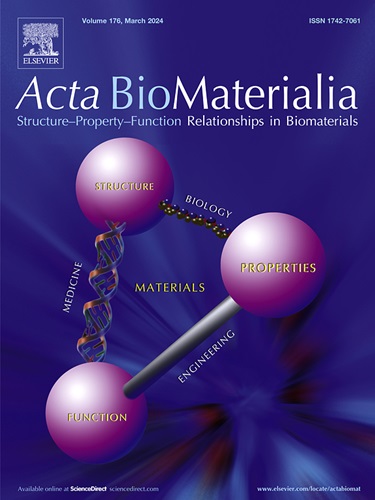CaGA纳米酶在溃疡性结肠炎治疗中抑制氧化应激和保护线粒体功能。
IF 9.4
1区 医学
Q1 ENGINEERING, BIOMEDICAL
引用次数: 0
摘要
溃疡性结肠炎(UC)是一种长期的炎症性肠病,其特征是结直肠粘膜的剧烈炎症。活性氧的过量产生加剧了UC的进展,这与线粒体损伤和肠道微生物群的生态失调有关。CaGA纳米酶已被证明对UC的治疗有效。通过CaGA纳米酶调节巨噬细胞的M1和M2极化已被证明有助于减轻炎症。此外,CaGA纳米酶调节巨噬细胞的M1和M2极化,有效地减少炎症。口服CaGA纳米酶导致其在结肠炎症区域富集,并通过改善肠道屏障的修复有效减轻dss诱导结肠炎小鼠的结肠损伤。一项对16S rDNA测序的研究表明,CaGA纳米酶通过影响三羧酸(TCA)循环来调节致病菌和有益菌的种群,并影响溃疡性结肠炎的进展。因此,CaGA纳米酶可用于溃疡性结肠炎的治疗,通过减少炎症细胞的入侵和恢复线粒体活性来控制肠道环境,改善肠道屏障的保存。意义声明:CaGA纳米酶表现出多功能酶活性,有效地消除细胞ron,具有强大的抗氧化能力。CaGA纳米酶促进巨噬细胞M1向M2极化,具有抗炎作用。CaGA纳米酶通过恢复受损的线粒体功能、减少活性氧(ROS)的产生和恢复线粒体产生ATP的能力来提高细胞活力。CaGA纳米酶调节肠道菌群的多样性和组成,可能通过芳香化合物代谢影响炎症途径。它们参与细胞能量和生物合成,通过三羧酸(TCA)和尿素循环调节溃疡性结肠炎(UC)相关肠道功能。钙离子与GA纳米药物结合,小颗粒容易被炎症细胞吸收,防止腹泻迅速排出。本文章由计算机程序翻译,如有差异,请以英文原文为准。

CaGA nanozymes inhibit oxidative stress and protect mitochondrial function in ulcerative colitis therapy
Ulcerative colitis (UC) is a long-term inflammatory bowel disease characterized by intense inflammation of the colorectal mucosa. Overproduction of reactive oxygen species exacerbates the progression of UC, which is linked to mitochondrial impairment and dysbiosis of the intestinal microbiota. CaGA nanozymes have demonstrated efficacy in the treatment of UC. The modulation of M1 and M2 polarization of macrophages by CaGA nanozymes has been demonstrated to be useful in reducing inflammation. Furthermore, CaGA nanozymes regulate the M1 and M2 polarization of macrophages, efficiently decreasing inflammation. The oral delivery of CaGA nanozymes resulted in their enrichment in inflamed areas of the colon and effectively reduced colonic damage in mice with DSS-induced colitis by improving the repair of the intestinal barrier. An investigation of 16S rDNA sequencing revealed that CaGA nanozymes regulate populations of both pathogenic and helpful bacteria and impact the progression of ulcerative colitis by influencing the tricarboxylic acid (TCA) cycle. Thus, CaGA nanozymes may be employed in the management of ulcerative colitis to control the intestinal milieu and improve the preservation of the intestinal barrier by decreasing the invasion of inflammatory cells and restoring mitochondrial activity.
Statement of significance
CaGA nanozymes exhibit multifunctional enzymatic activity, effectively eliminating cellular RONS with robust antioxidant capacity. CaGA nanoenzymes promote macrophage M1 to M2 polarization and produce anti-inflammatory effects. CaGA nanozymes increase cell viability by restoring impaired mitochondrial function, reducing reactive oxygen species (ROS) production, and restoring the ability of mitochondria to produce ATP. CaGA nanozymes modulate intestinal flora diversity and composition, potentially influencing inflammatory pathways via aromatic compound metabolism. They participate in cellular energy and biosynthesis, regulating ulcerative colitis (UC)-related intestinal function through the tricarboxylic acid (TCA) and urea cycles. Calcium ions bind to GA nanomedicine and small particles are readily absorbed by inflammatory cells, preventing diarrhea from being rapidly excreted.
求助全文
通过发布文献求助,成功后即可免费获取论文全文。
去求助
来源期刊

Acta Biomaterialia
工程技术-材料科学:生物材料
CiteScore
16.80
自引率
3.10%
发文量
776
审稿时长
30 days
期刊介绍:
Acta Biomaterialia is a monthly peer-reviewed scientific journal published by Elsevier. The journal was established in January 2005. The editor-in-chief is W.R. Wagner (University of Pittsburgh). The journal covers research in biomaterials science, including the interrelationship of biomaterial structure and function from macroscale to nanoscale. Topical coverage includes biomedical and biocompatible materials.
 求助内容:
求助内容: 应助结果提醒方式:
应助结果提醒方式:


